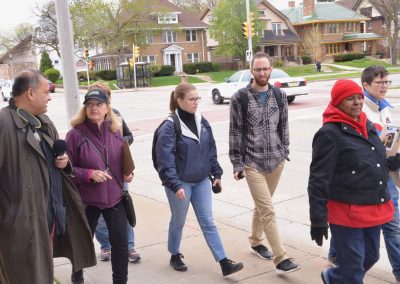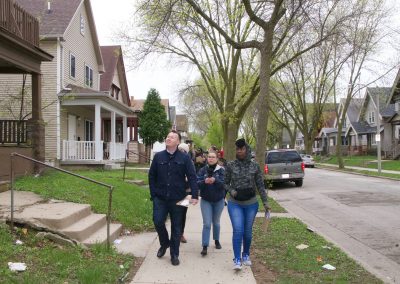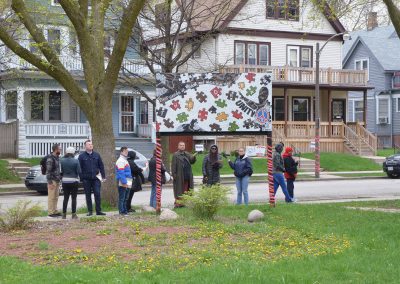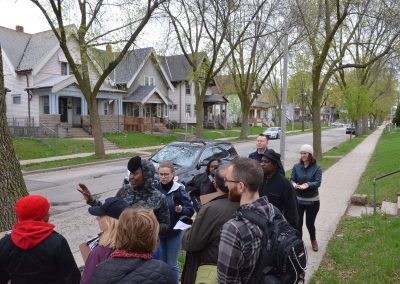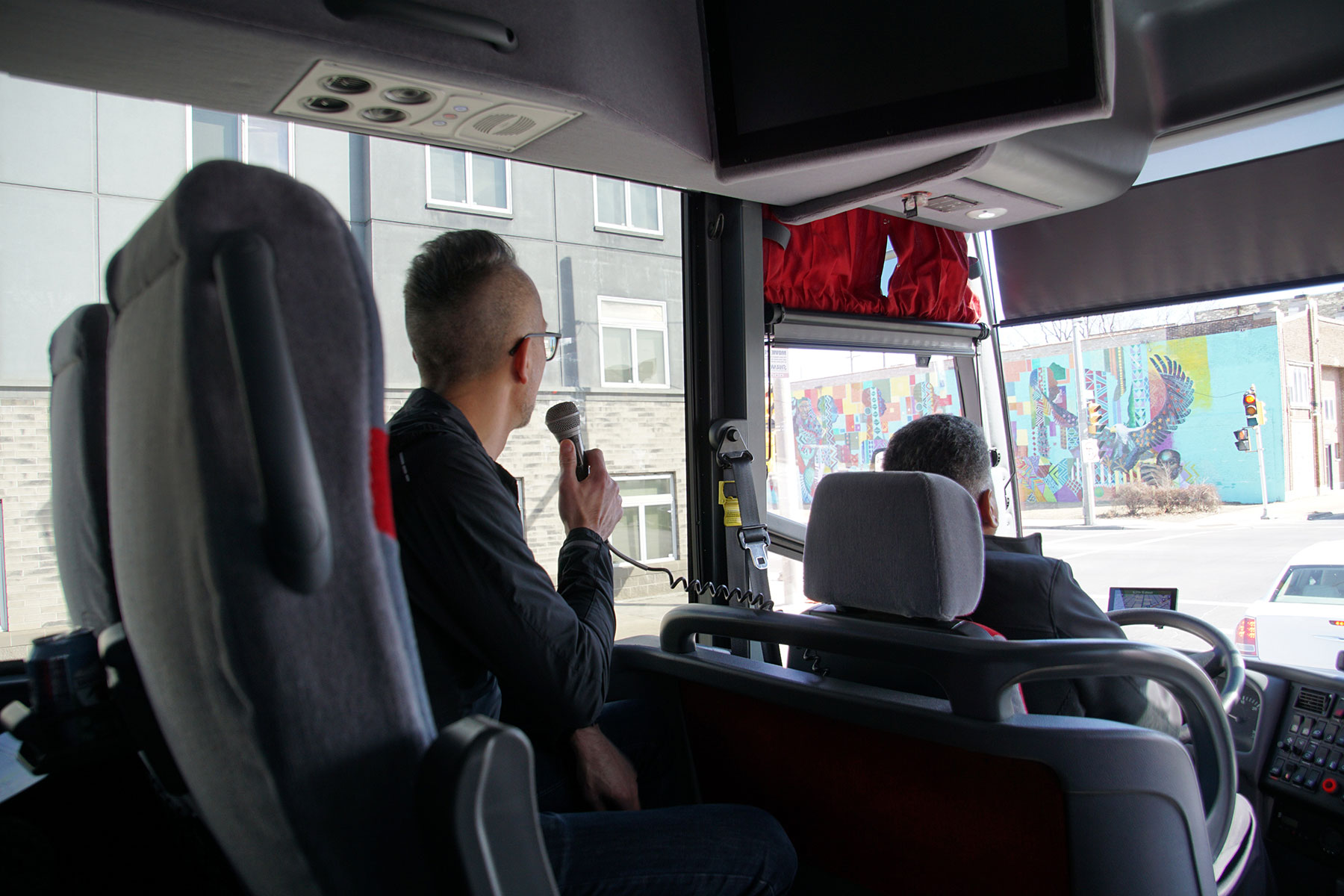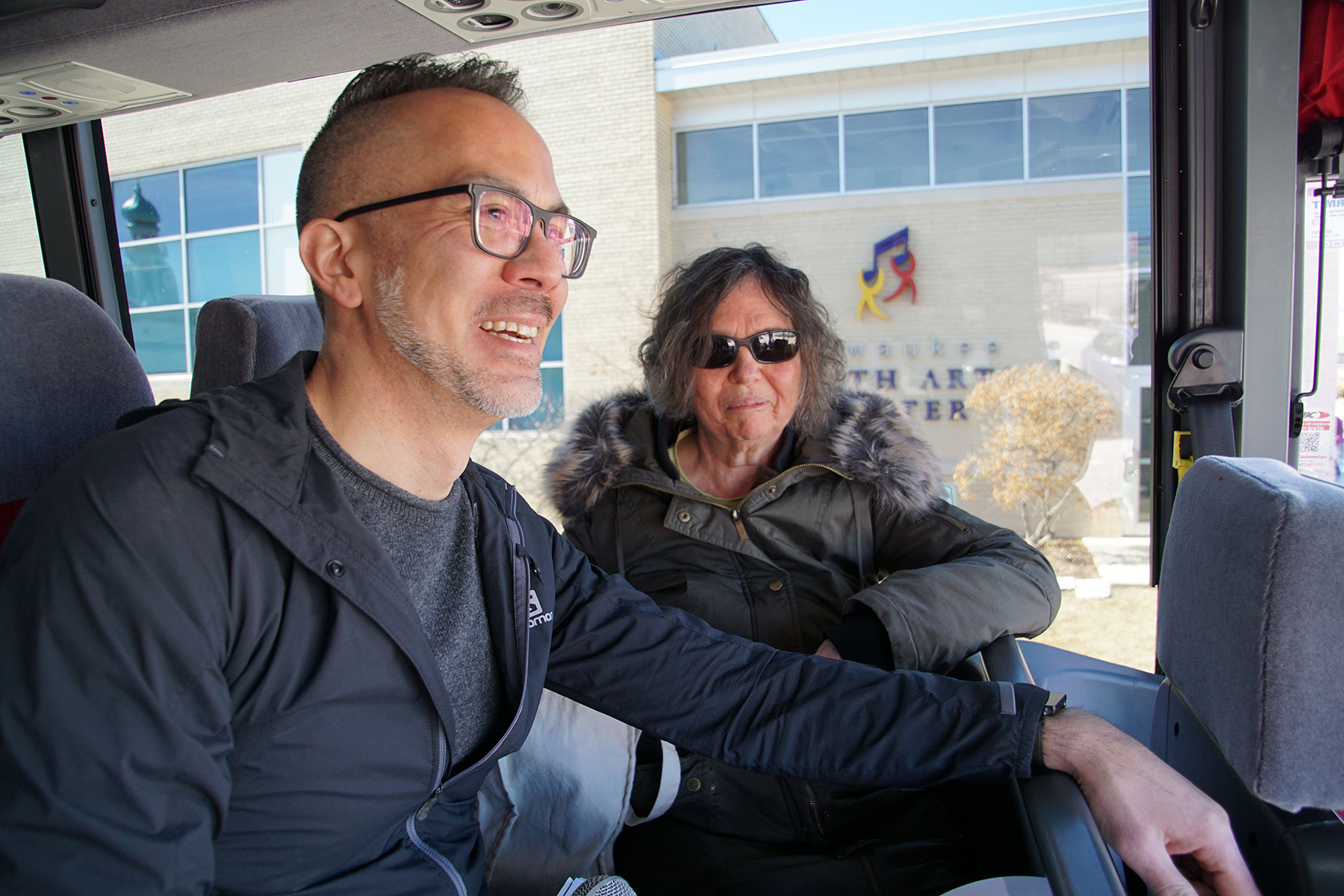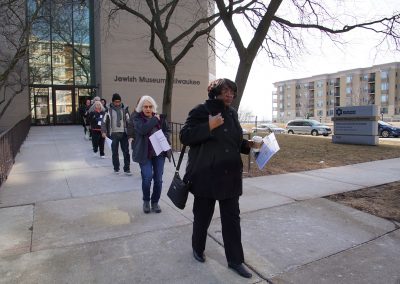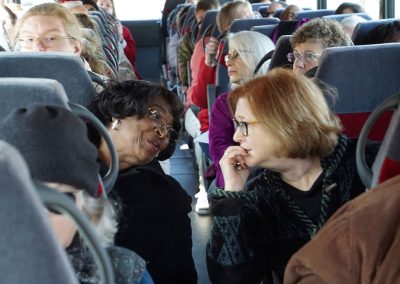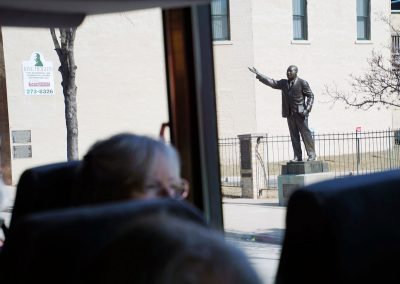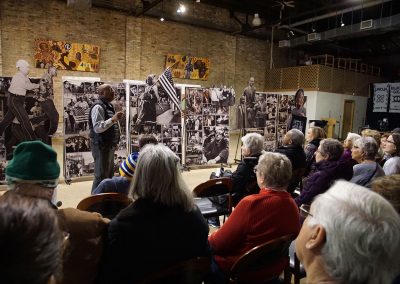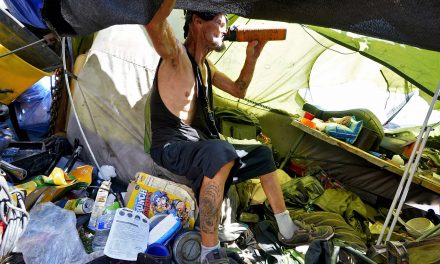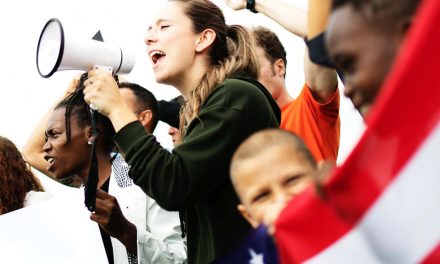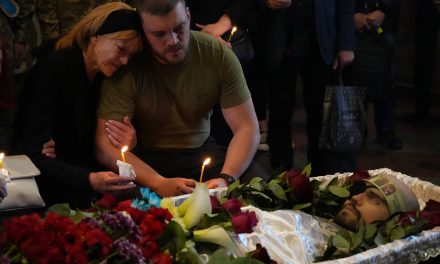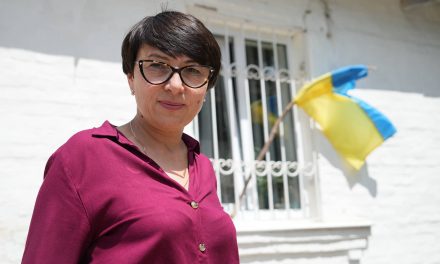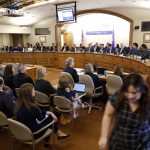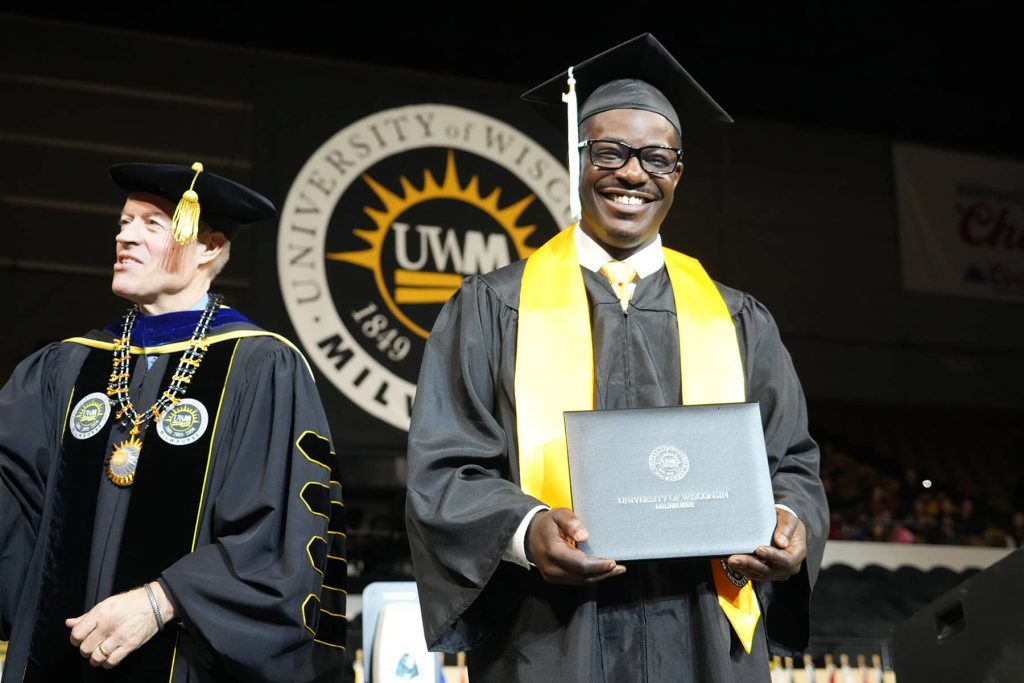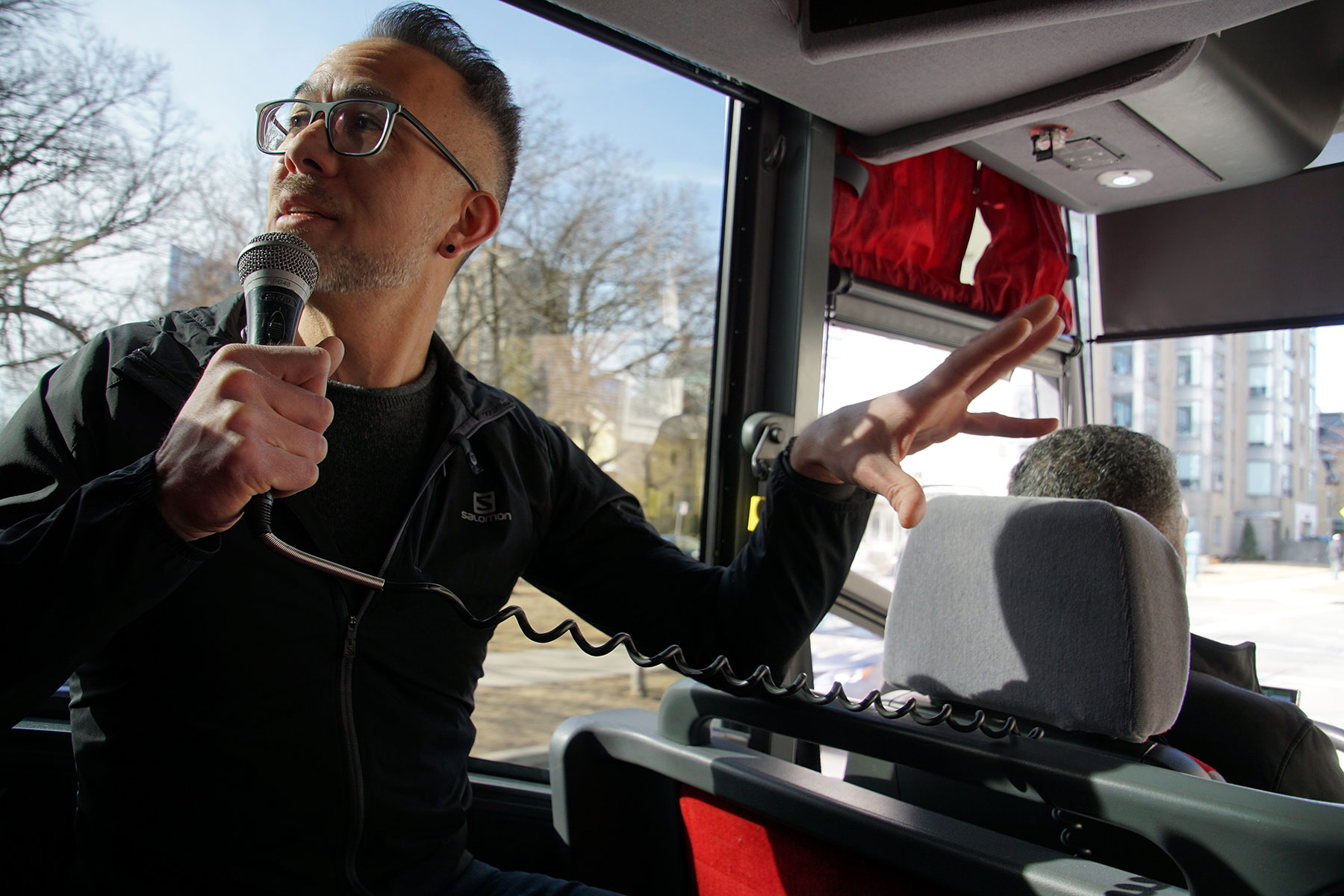
As Black History Month draws to a close, I have been reflecting on my past and future roles as a non-black Black History tour guide in Milwaukee. Earlier this week, I led a tour for a class of Shorewood High School students and this summer I will lead my third tour for Concordia University’s African American Male Achievement program. I keep asking myself, “Who am I to be leading these tours?”
I have been thinking about my identity as a non-black resident in the most segregated city in the country for a long time. The first day I arrived in Milwaukee in the summer of 1994, after a two-thousand-mile drive from my hometown of Seattle with my father, we looked up the nearest Target in the phone book and headed to what used to be called Capitol Court. I needed a few items for my new apartment on Marquette University’s campus, where I would begin graduate school. It only took a few moments to realize that we were the only non-black customers. My Japanese father (married to my Italian mother from Connecticut) and I didn’t think much of this observation other than to note it.
We were both familiar with Seattle’s segregation issues, and not necessarily in ways of which I am proud. My parents had leveraged my Japanese heritage to get me placed in Ingraham High School on the north side (which was the only school that offered the language) instead of Garfield High School on the south side, whose population was predominantly black, Latinx, and Asian. They were afraid of, you know, gangs and such. Needless to say, neither of us had a clue about Milwaukee’s segregation history. It would actually be years until I even learned about it. Shame on me. All I knew that first day in Milwaukee is that I looked different from mostly everyone at the Capitol Court Target.
As I began grad school and was introduced to a new word but familiar concept – Otherness – I determined that a primary literary focus would be on stories about individuals navigating spaces which had not been created for them. I had also recently come out as gay and was finally away from home and free to explore my authentic self, so I felt I could authentically commiserate with authors like Oscar Wilde and Alice Walker (although her gender and sexuality was something I could read about but never embody). When I would read non-white authors like Sherman Alexie or James Baldwin and learn from their stories of being from the Spokane-Coeur d’Alene reservation or from Harlem, New York, I confess I probably thought I could truly understand the pathos of their lives.
As an idealistic student of literature, I wanted to live vicariously through these authors, to let their pages be a mirror for my own developing self-image. The books, though, were not mirrors but doors into their worlds. No book can be a true mirror. Instead, what I had been doing was more akin to breaking and entering, cracking open the pages of Alexie and Baldwin and demanding to be legitimized. It would be but an entirely different – and more profound – thing to enter the lives of living people. I would eventually learn that whenever I wanted to enter the doors of the lives of non-book characters, such as my very real neighbors in Milwaukee, I would need to be invited in.
As someone who has had multiple opportunities to be a non-black Black history tour guide, I often thought about whether I have been invited or whether I am breaking and entering. Given our country’s shameful history and shameful present, I understand when writers like Kelsey Blackwell, in an August 2018 article, explain “Why People of Color Need Spaces Without White People.” She is not talking about Targets, of course. She argues eloquently for instances of “temporary physical segregation” (different from the institution of segregation) where the door is temporarily closed – literally – because white people have already done too much breaking and entering. People of color, she says, “need places in which they can gather and be free from the mainstream stereotypes and marginalization that permeate every other societal space they occupy.” They need places where they can be their authentic selves instead of deftly navigating white-dominated spaces all the time and finding ways to legitimize their actions or assimilate without sticking out too much.
I wonder what these places look like, and wonder whether a predominantly PoC neighborhood counts as such. Have I been breaking and entering into places with my tours that need the space and time to build and rebuild their collective identity? Is any place – neighborhood, business, place of worship, school – ever meant to be an “only”?
I remember vividly the first time I walked into Coffee Makes You Black – its walls adorned with photographs and art from African and Black American history – and felt palpable stares that followed me to the counter, eyes that questioned what someone who looks like me might be doing in a black-owned business in a predominantly black neighborhood when I could very well have gone a little further to the nearest Colectivo or Starbucks. The owners seemed skeptical as well, even more so when I talked about ZIP MKE – this was two years ago when we had just begun – and taking photographs of all 28 Milwaukee ZIP Codes, including 53206.
I felt like an outsider, especially when Bradley, one of the owners, was sure I would only take negative images of the neighborhood because that is what everyone in the media did. I assured him that was far from the case. (What I am shameful of now is that before I ventured into his cafe, I had, for some ignorant reason, decided to take photos in Union Cemetery just up the road. A sunlit photo of graves was the first photo I featured for 53206.) But now I can walk in and be greeted with smiles, coffee, and sometimes a sit-down from owners Bradley and his wife Laurie, Anthony who sells books and cards, my friends Gab and Vaun, the staff.
Bradley and Laurie could have created a “space without white people,” but I do not believe they set out to do so. They serve the community and their customers, because of the coffee shop’s location, just happen to be mostly black. And why I am accepted, I think, is because I have built trust and relationships, because I have revealed my vulnerabilities as well as my knowledge and talents, and, on top of that, because I keep coming back to support their work. Last year, Coffee Makes You Black was kind enough to allow ZIP MKE to exhibit in their space.
When I founded ZIP MKE, I made sure that all 28 ZIP Codes were represented at least superficially (the goal was always to crowdsource photos from residents) by taking photos in every one of those 28 areas. It was a solo project that made me realize how much I did not really know Milwaukee at all (did I mention that I live in Wauwatosa?). And I know I wondered how I would be perceived as a stranger-with-a-camera in every neighborhood I entered, most of all in neighborhoods with residents who were predominantly PoC.
Since ZIP MKE started hosting walk and talks, and once I got involved with Jane’s Walk MKE – both of which seek to expand the city’s social perspectives, to re-image and re-imagine who we are and who we could become – I have led ten walks and bus tours of spaces that are not primarily my own. Gamboling through the Tippecanoe neighborhood or through Pigsville never gave me pause. They are predominantly white. And those walks were mostly exploratory.
But when I have given tours through predominantly black neighborhoods to educate participants about aspects of Milwaukee’s PoC history, I have always been aware that I am a non-native Milwaukeean of Japanese and Italian descent walking or bussing through a neighborhood that I do not live in. It is the same awareness I have had when I visit predominantly black or brown neighborhoods with my camera for ZIP MKE. With my camera, then, I have learned to build rapport, trust, and even relationships with my subjects. On my tours, I have learned that I always need to carry an extensively researched script and try to do the same things.
The first time I gave such a tour was for Jane’s Walk MKE. Walkers and I made a five-mile trek from Ammar Nsoroma’s bas-relief mural under I-94 of Joshua Glover and Caroline Quarles to Clarke Square on the south side. This “art and justice” trail first included a loop that went north through Bronzeville then south through Westown, across the 16th Street bridge, and down Cesar Chavez Drive. I punctuated the trail with my historical research and made intentional stops at the statues of Sojourner Truth, Dr. King, Gandhi, Mother Teresa, and Chavez, as well as many cultural murals from black and brown artists. I gave a similar tour the following year for Doors Open Milwaukee.
Part of my anxiety (and embarrassment) each time was my reliance on the script. There was just no way that I could memorize all that information and relay it during a walk while also paying attention to time, my participants, answering question, and not getting lost. I am also not a trained historian like, say, the inimitable Reggie Jackson, my co-columnist for this magazine, with a repertoire of internalized stories about the people and places and experiences that led us to present-day Milwaukee. I also did not grow up here, let alone experience any of the pinnacle events that my script contains, let alone as a non-black or brown resident.
The other anxiety was taking twenty mostly non-black walkers through Bronzeville and Clarke Square. I feared being perceived as what is known as a “safari tour,” many of which visit blighted or forgotten parts of big cities to take photos and feel good about themselves. Such tours have been widely critiqued for taking mainly white participants into mainly PoC neighborhoods to gawk and walk… away. Even though Bronzeville and Clarke Square are experiencing renaissances, I still knew something did not feel quite right.
I clearly remember the executive director of the King Drive BID, Deshea Agee, helping me work through some of my missteps, like not talking to business owners before the tour to let them know what we were doing, our intentions, and so on – and, even, seeking their permission to enter the doors of their neighborhood, literally and figuratively. I remember making excuses – “We were going to contact everyone but ran out of time” and “You know, there’s a value to getting people out of their comfort zones and into other neighborhoods.” Thankfully, Agee graciously joined me on the tour and lent much needed first-hand knowledge and enthusiasm about the neighborhood which he was helping to thrive.
I learned some good lessons from that experience. And as for being apologetic at the beginning of my tours relying on a script, I am not anymore. Because I need the script. This is why on my Shorewood High School tour this week, which focused on the Open Housing Marches of 1967-68, the first thing I did was hold up my script and say, “I’ll be holding a script at all times – even reading from it. Why? Because I was not there. And I am not black. And a part of me has always felt uncomfortable being a non-black person giving a tour like this focused on Black History, especially during Black History Month.” I added, “But it’s important for someone to tell it – and right now, I have the time and energy to do be your guide so that you can be better equipped with knowledge of the city’s history. And I’ve done my research, as a non-black person, because I know I shouldn’t have to rely on black people to teach me about racism and about our racist history. I need to do it for myself. Therefore, I will rely on my research of a truth that hasn’t been, until only recently, taught in Milwaukee schools, let alone Shorewood schools.”
I am finding that the more I am transparent about what I know and what I do not know, the better. I am not an expert on Milwaukee or racism, I just do my research. I’m a learner, as we all should be. As all non-black people should be.
I have given the same tour that I offered Shorewood High School three times already, twice for the Closing the Achievement Gap Consortium (CAGC) African American Male Initiative (AAMI) program and once for the Jewish Museum Milwaukee. When activist, storyteller, and experienced Milwaukee tour guide Adam Carr was not able to lead the AAMI tour two summers ago, he kindly referred them to me. I had walking tours under my belt, but no bus tours. It is one thing to have a walk with 30-40 participants who can spread out, walk at their own pace, meet up at stopping points, and so on. It would be another thing to have 30-40 young black men trapped with me in a moving bus. Could I keep their attention and interest? More importantly, would they trust me? It was still hard for me – but natural I think – to buck those anxieties.
CAGC AAMI is a partnership between Milwaukee-area high schools and Concordia University that works with more than 150 young men throughout their high school career to close the achievement gap between them and their non-black peers (many of the students attend predominantly white suburban schools). They develop self-awareness in their freshman year, work in teams their sophomore year, connect with the community the next year (which is the group of students I have toured with during the annual Summer Institute), and finally become leaders in training before graduating.
Connecting the students to the Milwaukee community – in about three hours – was going to be tough. So I stepped up my research game and learned as much about the Open Housing Marches as I could (some of it from Carr’s work organizing the 50th anniversary of the marches). I needed to demonstrate to the young men – and their mentors – that I had done my homework. We took a bus ride through Lindsay Heights and Bronzeville, then south to the foot of the 16th Street bridge that 200 marchers dared to cross the first night of the marches. On the way, we stopped at multiple sites that featured prominently in the marches. And to bring the historical portion of the tour into the present, we stopped at community gathering spaces like Alice’s Garden and The Juice Kitchen so the students could see change at work in the black community. The second year we got to the see the site of the Griot, where the new America’s Black Holocaust Museum was still just a shell, but a strong symbolic shell at that.
I earned their trust and respect. Last summer, the Jewish Museum Milwaukee entrusted me to lead a very similar tour augmented with the history of how Jewish and black residents worked together to fight racism in Milwaukee. We made stops at the Wisconsin Black Historical Society and Museum, where Clayborn Benson III gave a rousing history of school desegregation. Benson had made me ensure that Lloyd Barbee’s role in fighting racism was highlighted; he got his way. I even told him that I would let him approve my tour script; he did, especially after seeing how extensive it was. (The only thing I worried about with that tour was that we would be riding a humongous Coach bus up and down Center Street and North Avenue. There would be no missing us. I had Blackwell’s article on my brain before I even read it.) Then, recently, one of the mentors on last summer’s tour recommended me to two teachers at Shorewood High, who requested that I replicate the Open Housing Marches tour and add a March murals tour.
Renee Glembin, an English teacher, and Jess Mohagen, an art teacher, are teaching a new class called “Exploring Social Activism Through Image & Word,” which they just developed for this school year. Partly an answer to the school district’s call for more authentic learning, the class went straight for some of the most difficult issues facing our country today. They have explored the Black Lives Matter movement, white privilege and fragility, mass incarceration, and the school-to-prison pipeline. Because both Glembin and Mohagen are white, they have designed a class culture that allows everyone, including themselves, to be free to share, question, make mistakes, and work through those mistakes. They blend reading, writing, and art to create many avenues for expression throughout, all of which culminates in a capstone presentation that will educate community members about an issue important to them. While not all their students live in Shorewood, one main goal of the class is to get all of them out of their “community bubbles” to explore not just issues but the City of Milwaukee itself. Hence, this semester, their desire for two tours.
As much as I want to live in a utopia where I do not have to – where no one has to – worry about the racial logistics of a little bus tour, I will likely have to for a long time. And because we live in this kind of present, with our kind of past, I should have to. Like I did for AAMI, I built in a living, breathing change-maker spot. This time, the choice was a no-brainer: the recently opened Sherman Phoenix. I could use the downstairs art gallery to give them a little stretch from the bus ride and fill in some history before the marches (especially the formation of the NAACP and the Youth Council), but they would also have time to venture upstairs to spend some money at the twenty-nine black-owned businesses, including Funky Fresh Spring Rolls, Next Level Vegans, and, of course, Shindig Cafe (owned by the same people as The Juice Kitchen – Maanaan Sabir and JoAnn Johnson-Sabir, one of the two developers of the Phoenix).
I know what you are thinking, because I was thinking it, too: what did the class at Shorewood High look like? I could not imagine they were all white, but if they were, what would be the effect of thirty white high school students from Shorewood crossing the threshold into the Phoenix? What would Blackwell say?
While yes, the Sherman Phoenix was developed to be a “model for healing our city by generating positive economic and social returns in communities of color,” it is an inclusive space for not only the Sherman Park community or people of color but for all Milwaukee residents who want to invest time and dollars in a beautiful community asset. So when I contacted JoAnn Johnson-Sabir, who I know from patronizing The Juice Kitchen since it opened, and let her know (thank you, Deshea Agee) we would be making a stop on our tour, she told me, “The Phoenix will receive the young folks with open arms.” Blackwell’s argument about PoC-only spaces is indeed valid. The Sherman Phoenix, however, like Coffee Makes You Black, just is not one of those spaces. If they were, though, I would hope that I would respect that. So yes, I have been reflecting a lot about my identity and role as a non-black Black History tour guide. I still have much to learn, much to encounter, much to experience and ponder.
A few days ago, when meeting with Randee Drew, the Head Director and Chair of AAMI, about my next tour this summer, I asked him, point blank, “Why me?” His initial response made us both laugh: “You came highly recommended, and your specialty was completely in line with the theme of community. But before I met you, I honestly thought you were black due to your last name, which I believed to be African. So my ignorance led me to assume you were a black man because of your name and your apparent specialty in African American history.” I had been told multiple times before by black friends and acquaintances that my Japanese last name is common in West African nations like Nigeria.
Drew admits that when he met me, then, “I suppose my anxiety toward the situation was because of the unknown. I assumed that you could lose credibility with your audience because you were not an African American male.” It made sense that if I had been having those doubts that he should also. I was happy to hear, however, that my tours had been well accepted, that the young men and the mentors had “gained credible knowledge of and a connection and access they did not have to their own city.”
Drew added that “the more individuals who are non-black have a sense of their own privilege and a sense of the history that has hindered, marginalized, and suppressed black people, the more it can be corrected over time. Empowering others to do right is never a bad thing.”
Who am I to be leading these tours? I am still trying to formulate an answer. But I am getting closer with every step.
© Photo
Dominic Inouye and Lee Matz

